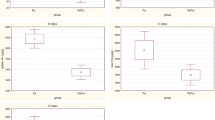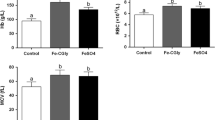Abstract
The metabolism of iron (Fe) has been shown to interact with that of aluminum (Al) in relation to intestinal absorption, transport in the blood plasma, and the induction of lipid peroxidation and cellular damage. Also, dietary supplementation with citrate has been shown to increase the absorption of both metals and, in the presence of high intakes of Fe and Al, leads to excessive accumulation of both metals in the body. In this study, the likely interaction between Al and internal Fe metabolism was investigated using rats fed diets that were either deficient, sufficient, or loaded with Fe, with or without the addition of Al and sodium citrate. These diets commenced when the rats were 4 wk old and were continued for 9–11 wk. At that time, Fe metabolism as assessed by measurement of organ uptake of59Fe and125I-transferrin, after iv injection of transferrin labeled with both isotopes, plus measurement of tissue concentrations of nonheme Fe and Al. The Fedeficient diet and Fe-loaded diet led to states of Fe deficiency and Fe overload in the rats, and supplementation of the diet with Al increased Al levels in the kidneys, liver, and femurs, but, generally, only when the diet also contained citrate. Neither Al nor citrate supplementation of the diet had any effect on nonheme Fe concentrations in the liver, kidney, or brain, or on the uptake of59Fe or125I-transferrin by liver, kidney, brain, or spleen. Only with the femurs was a significant effect observed: increased59Fe uptake in association with increased Al intake. Therefore, using this animal model, there was little evidence for interaction between Fe and Al metabolism, and no support was obtained for the hypothesis that dietary supplementation with Fe and citrate can lead to excessive Fe absorption and deposition in the tissues.
Similar content being viewed by others
References
J. B. Cannata, I. Fernández-Soto, M. J. Fernández-Menendez, J. L. Fernández-Martin, S. J. McGregor, J. H. Brock, et al., Role of iron metabolism in absorption and cellular uptake of aluminum,Kidney Int. 39, 799–803 (1991).
A. L. Florence, A. Gauthier, C. Ponsar, P. Van den Bosch de Aguilar, and R. R. Crichton, An experimental animal model of aluminum overload,Neurodegeneration 3, 315–323 (1994).
G. A. Trapp, Plasma aluminum is bound to transferrin,Life Sci. 33, 311–316 (1983).
M. Cochran, J. Coates, and S. Neoh, The competitive equilibrium between aluminium and ferric ions for the binding sites of transferrin,FEBS Lett. 176, 129–132 (1984).
R. B. Martin, J. Savory, S. Brown, R. L. Bertholf, and M. R. Wills, Transferrin binding of the Al3+ and Fe3+,Clin. Chem. 33, 405–407 (1987).
S. J. A. Fatemi, F. H. A. Kadir, and G. R. Moore, Aluminum transport in blood serum. Binding of aluminum to human transferrin in the presence of human albumin and citrate,Biochem. J. 280, 527–532 (1991).
R. B. Martin, The chemistry of aluminum as related to biology and medicine,Clin. Chem. 32, 1797–1806 (1986).
B. Halliwell and J. M. C. Gutteridge, Oxygen free radicals and iron relation to biology and medicine: some problems and concepts.Arch. Biochem. 246, 501–514 (1986).
R. S. Britton, A. S. Tavill, and B. R. Bacon, Mechanisms of iron toxicity, inIron Metabolism in Health and Disease, J. H. Brock, J. W. Halliday, M. J. Peppard, and L. W. Powell, eds., Saunders, London, pp. 312–351 (1994).
J. M. C. Gutteridge, G. J. Quinlan, I. Clark, and B. Halliwell, Aluminum salts accelerate peroxidation of membrane lipids stimulated by iron salts,Biochim. Biophys. Acta 835, 441–447 (1985).
G. J. Quinlan, B. Halliwell, C. P. Moorhouse, and J. M. C. Gutteridge, Action of lead (II) and aluminum (III) ions on iron-stimulated lipid peroxidation in liposomes, erythrocytes and liver microsomel fractions,Biochim. Biophys. Acta,962, 196–200 (1988).
C. X. Xie and R. A. Yokel, Aluminum facilitation of iron-mediated lipid peroxidation is dependent on substrate, pH, and aluminum and iron concentrations,Arch. Biochem. Biophys. 327, 222–226 (1996).
J. L. Greger, Aluminum metabolism,Annu. Rev. Nutr. 13, 43–63 (1993).
W. Frech and A. Cedergren, Aluminum concentrations in the brain and bone of rats fed citric acid, aluminum citrate or aluminium hydroxide,Food Chem. Toxicol. 22, 391–397 (1984).
T. S. Brown and R. Schwartz, Aluminum accumulation in serum liver and spleen of Fe-depleted and Fe-adequate rats.Biol. Trace Element Res. 34, 1–10 (1992).
C. A. Ecelbarger and J. L. Greger, Dietary citrate and kidney function affect aluminium, zinc and iron utilization in rats,J. Nutr. 121, 1755–1762 (1991).
M. Gillooly, T. H. Bothwell, J. D. Torance, A. P. McPhail, D. P. Derman, W. R. Bezwoda, et al. The effects of organic acids, phytakes and polyphenols on the absorption of iron from vegetables,Br. J. Nutr. 49, 331–342 (1983).
D. Ballot, R. D. Baynes, T. H. Bothwell, M. Gillooly, B. J. MacFarlane, A. P. Macphail, et al. The effects of fruit juices and fruits on the absorption of iron from a rice mealBr. J. Nutr. 57, 331–342, (1987).
M. Gardiner and E. H. Morgan, Transferrin and iron uptake by the liver in the rat,Aust. J. Exp. Biol. Med. Sci. 52, 723–736 (1974).
D. Trinder, E. Morgan, and E Baker, The effects of an antibody to the transferrin receptor and of rat serum albumin on the uptake of diferric transferrin by rat hepatocytes,Biochim. Biophys. Acta. 943, 440–446 (1988).
J. G. Bieri, G. S. Stoewsand, G. M. Briggs, R. M. Phillips, J. C. Woodward, and J. J. Knapka, Report on the American Institute of Nutrition ad hoc committee on standards for nutritional studies,J. Nutr. 107, 1340–1348 (1977).
H. A. Huebers, G. M. Brittenham, E. Csiba, and C. A. Finch, Absorption of carbonyl iron,J. Lab. Clin. Med. 108, 473–478 (1986).
E. Taylor, A. Crowe, and E. H. Morgan, Transferrin and iron uptake by the brain: effects of altered iron status,J. Neurochem. 57, 1584–1592 (1991).
International Committee for Standardization in Haematology, The measurement of total and insaturated iron-binding capacity in serum,Br. J. Haematol. 38, 281–290 (1978).
I. Kaldor, The measurement of non-haem tissue iron,Aust. J. Biol. 32, 795–800 (1954).
R. D. Crawford, Proposed role for a combination of citric acid and ascorbic acid in the production of dietary iron overload: a fundamental cause of disease,Biochem. Mol. Med. 54, 1–11 (1995).
S. J. McGregor, M. L. Naves, R. Oria, J. K. Vass, and J. H. Brock, Effect of aluminum on iron uptake and transferrin receptor expression by human erythroleukaemia K562 cells,Biochem. J. 272, 377–382 (1990).
P. R. Dallman, M. A. Siimes, and E. C. Manies, Brain iron: persistent deficiency following short-term iron deprivation in the young rat.Br. J. Haematol. 31, 209–215 (1975).
D. Ben-Shachar, R. Ashbenazi, and M. B. H. Vondim, Long-term consequence of early iron-deficiency on dopaminergic neurotransmission in rats,Int. J. Dev. Neurosci. 4, 81–88 (1986).
A. C. G. Chua and E. H. Morgan, Effects of iron deficiency and iron overload on manganese uptake and deposition in the brain and other organs of the rat.Biol. Trace Element Res. 55, 39–54 (1996).
W. A. Jefferies, M. R. Brandon, S. V. Hunt, A. F. Williams, K. C. Gatter, and D. Y. Mason, Transferrin receptor on endothelium of brain capillaries,Nature 312, 161–163 (1984).
Author information
Authors and Affiliations
Rights and permissions
About this article
Cite this article
Morgan, E.H., Redgrave, T.G. Effects of dietary supplementation with aluminum and citrate on iron metabolism in the rat. Biol Trace Elem Res 65, 117–131 (1998). https://doi.org/10.1007/BF02784264
Received:
Accepted:
Issue Date:
DOI: https://doi.org/10.1007/BF02784264




